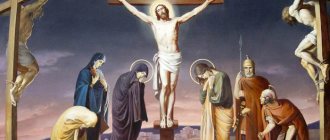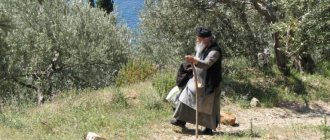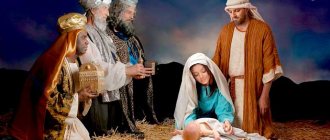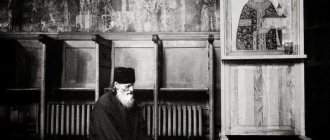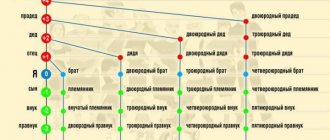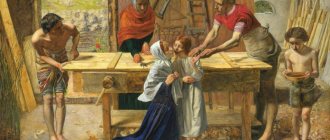When Jesus Christ was crucified, two robbers were executed along with him. Their names were Gestas and Dismas. In history, the most famous criminal is Barrabas, who should also have been executed on this day, but Pontius Pilate pardoned him on the occasion of Easter. But the bandits who died next to the Savior are little known.
Photo: School.orthpatr.ru
For what crime was the Prudent Thief crucified?
The word thief, used in the Synodal Translation of the Holy Scriptures, also has the meaning of rebel (terrorist). Considering that Judea at that time was occupied by the Roman Empire, such a translation as partisans is also appropriate.
In those days, theft was not punished by crucifixion, so it can be assumed that the robbers crucified next to Christ the Savior waged an armed struggle against the invaders, and did not trade in robbery.
Lopukhin A.P.
Also the thieves who were crucified with Him reviled Him
(Mark 15:32). The testimony of Matthew and Mark is similar here: Christ was reviled by both robbers. But Luke (23:39 ff.) speaks only of one robber who reviled him, and another appeased him
This difference has attracted attention for a long time. Origen, Chrysostom, Theophylact, Euthymius Zigaben and others believed that at first both thieves blasphemed Christ, then one of them, seeing the long-suffering of Christ, repented, began to calm the other, and finally uttered his words (Lk
23:42). But Jerome says that here is a figure of speech called in Greek σύλληψις - a word that means “grasping,” but here it can be translated as abbreviation, connection - pro uno latrone uterque inducitur blaspemasse (instead of one robber, the evangelist forces both to slander). Augustine says that Matthew here, speaking briefly, put the plural instead of the singular. Meyer calls this plural “generic,” which has a necessary relation to Art. 38. We can agree with these interpretations and admit that Matthew and Mark, who do not speak about the repentant thief, generally wanted to show that curses were initially heard not only from among the people (not all), the high priests, elders and scribes, but also from outside robbers. Luke also notes that they were also heard from the soldiers (23:36, 37), which is not found in Matthew and Mark. There was a lot of slander and blasphemy, and, in fact, it was difficult to even make out where they were coming from. If Luke singles out one robber from this mass of detractors, then this, of course, does not in the least contradict either Matthew or Mark. That αυτό does not mean “in the same way,” but “the same,” i.e. ridicule and blasphemy, according to the construction of όνειδίζειν τινά τι - to blame someone for what. John here introduces a story about the women who stood at the cross and the commission of the Mother of God to John.
Explanatory Bible.
On the meaning of the penitential feat of the Prudent Robber
Priest Afanasy Gumerov:
A great change took place in the soul of the robber. He turned out to be worthy of heaven. The grace of God healed him, but we should not belittle his personal merit. The converted robber accomplished three feats. First of all, a feat of faith . The scribes and Pharisees, who knew all the prophecies about the Messiah and saw numerous miracles and signs performed by Jesus Christ, turned out to be blind and sentenced the Savior to death. The thief was able to see God incarnate in a man chained, like himself, to a cross and doomed to death. What an amazing power of faith. He also accomplished a feat of love . He died in suffering. When a person is tormented by unbearable pain, he is entirely focused on himself. The former thief, being in such a state, was able to show compassion for Jesus. When another thief slandered Him, he calmed him down and said: “He has done nothing wrong” (Luke 23:41). Do we have so much love for Jesus Christ, who receive so many benefits from God? The prudent robber accomplished the third feat - the feat of hope . Despite such a dark past, he did not despair of his salvation, although, it seemed, there was no longer time for correction and the fruits of repentance.
Way of the Cross of Jesus Christ
Each of the four Evangelists talks
about the Way of the Cross .
In Pretoria
They tear off Christ’s
purple robe
and clothe him in his clothes.
The Savior takes up his cross,
the way of the cross
begins .
Christ was followed by “a great multitude of people and women, who wept and lamented for him” (Luke 23:27). They also led two robbers condemned to death.
Having been brought to Golgotha, those sentenced to death were given wine mixed with myrrh (resin) to drink, but Jesus did not accept it.
After the crucifixion, the Roman soldiers divided Christ's clothes and cast lots to see who would get the tunic. And nearby “at the cross of Jesus stood His Mother and His Mother’s sister, Mary of Cleopas, and Mary Magdalene.” (John 15:25)
Who helped the Savior carry the Cross
Evangelist Luke tells about who helped Jesus Christ:
Cyrene is a city in Libya. This episode has great symbolic meaning. Thus, it is not an Israeli who serves the Lord, but a person who is a stranger by birth. The sacrament of the Old Testament sacrifices is no longer valid; the Cross of Christ is intended for the whole world, for all peoples.
Legends about the meeting of the Prudent Thief with the Holy Family
There is a later popular legend that it was a prudent robber who saved the lives of the Mother of God and the Baby Jesus on the road to Egypt, when Herod’s servants were killing all the babies in Judea. On the road to the city of Misir, the Holy Family was attacked by robbers with the intention of profiting. But righteous Joseph had only a donkey, on which the Most Holy Theotokos sat with her Son; the possible profit of the robbers was small. One of them had already grabbed the donkey, but when he saw the Infant Christ, he was surprised at the extraordinary beauty of the child and exclaimed: “If God had taken a human body for Himself, He would not have been more beautiful than this child!” And this robber ordered his companions to spare the travelers. And then the Blessed Virgin said to such a generous thief: “Know that this baby will reward you well for preserving him today.” This robber was Rakh.
Another legend conveys differently the meeting of the prudent robber with the Holy Family. E. Poselyanin describes it this way: “Seized by robbers, the travelers were brought to their den. There lay the sick wife of one of the robbers, who had an infant. The mother's illness had a hard impact on the child. He tried in vain to suck a drop of milk from her exhausted breast. The Mother of God saw the suffering of the child, the torment of the unfortunate mother. She walked up to her, took the baby into her arms and put him to her chest. And from the mysterious drop that penetrated the fading body, life instantly returned to the withered child. The cheeks became rosy, the eyes sparkled, and the half-corpse turned back into a cheerful, blooming boy. This was the effect of the mysterious drop. And in this boy there remained for the rest of his life the memory of the wonderful Woman, with whom he, dying, was healed. Life had not been kind to him; he followed the path of crime trodden by his parents, but spiritual thirst, the desire for the best never left this ruined life. (Viller E. Mother of God. Description of Her earthly life and miraculous icons). Of course, this baby turned out to be Rakh.
Crucifixion
Execution
through the Crucifixion was not only painful, but also shameful in the ancient world.
According to Jewish law, anyone executed in this way was considered cursed, which is why the high priests doomed the one who was called the King of the Jews
.
The slow execution was accompanied by incredible suffering. Even in those cruel times, they tried to ease the torment of those crucified by giving them a drink that dulled their consciousness. But Christ refused, his suffering was voluntary, an atoning sacrifice for sins
humanity.
Evangelist Luke quotes the Savior’s first words spoken from the cross: “Father, let them go; for they know not what they do” (Luke 23:34).
The evangelists also tell us about the ridicule that Christ suffered on the cross. Roman soldiers, Pharisees and scribes, and even robbers, crucified next to Jesus Christ, invited him to come down from the cross and perform a miracle.
But the real miracle was the repentance of the prudent robber. Having admitted his sins, recognizing Christ as the Messiah, the thief turned to him with words of repentance:
The Lord's death on the cross was preceded by darkness, which covered the earth from noon to three hours. The Savior’s last words were: “Father, in Your hands I commend My spirit” (Luke 23:46). At the moment of his death, the temple curtain separating the Holy of Holies was torn in two. The New Testament opened the entrance to the Kingdom of Heaven for humanity.
Pagan Temple of Venus
The fact that modern Golgotha is located in the center of the Old Town is the result of Roman redevelopment, which began just a few years after the Crucifixion of Christ. Jerusalem was destroyed by the Roman emperors Vespasian and Hadrian. The Romans founded the new city of Aelia Capitolina not above old Jerusalem, but to the north of it.
We advise you to study Who are Cain and Abel?
The rocks were covered with soil, and the Capitol and the adjacent sacred temple site (temenos) were erected on the leveled area. The tomb of Christ was also filled up. On the site of Golgotha, a temple to the pagan goddess Venus was erected.
Only 320s. Emperor Constantine the Great ordered the demolition of Roman buildings and opened the tomb of the Savior. The emperor's mother, Equal-to-the-Apostles Queen Helena, received the Holy Cross of the Savior in 326. Three crosses were found. To find out which of them is the Life-Giving Cross, a recently deceased person was attached to all three. The Cross of the Savior resurrected him.
In what sense is the expression “ascend to Golgotha” used?
The expression “ascend to Golgotha” is rarely used today. People remember these words in moments of suffering and severe shock, because this expression means “to be subjected to severe physical and moral tests, to suffer.”
Crucifixion of the Lord Jesus Christ with those coming
Today Golgotha is one of the two greatest shrines
Christianity (along with the Holy Sepulcher, where the
resurrection
of the Savior took place).
Unfortunately, not all pilgrims can visit Jerusalem. But fortunately, particles of the Life-Giving Cross are kept in some churches and monasteries in Russia:
- Alexander-Svirsky Monastery in the Leningrad region;
- Annunciation and Holy Cross monasteries in Nizhny Novgorod;
- Epiphany Yelokhovsky Cathedral in Moscow;
- Fedorovsky Monastery in the Ivanovo region;
- Holy Cross Monastery in Yekaterinburg;
- Pokrovsky Alexander Nevsky Monastery in St. Petersburg;
- Trinity Cathedral of the Trinity-Sergius Lavra.
1
April 2016
A particle of the Life-giving Cross of the Lord was transferred to the Holy Cross monastery of the Alexander-Svirsky Monastery, which is located in St. Petersburg.
Marina Rogova
About the Baptism of the Prudent Thief
“... the thief received the sprinkling of remission of sins through the sacrament of water and Blood flowing from the side of Christ” (St. Ephraim the Syrian, Creations, vol. 4, p. 434).
“...what was the robber’s justification? He entered heaven because he touched the cross with faith. What happened next? The thief was promised salvation by the Savior; Meanwhile, he did not have time and was not able to realize his faith and be enlightened (by baptism), and yet it was said: “Whoever is not born of water and the Spirit cannot enter the Kingdom of God” (John 3:5), There was no There was no opportunity, no opportunity, nor time for the thief to be baptized, because he was then hanging on the cross. The Savior, however, found a way out of this hopeless situation. Since a man defiled by sins believed in the Savior and needed to be cleansed, Christ arranged it so that after suffering one of the soldiers pierced the side of the Lord with a spear and blood and water flowed out of him; from His side, says the evangelist, “immediately blood and water flowed out” (John 19:34), confirming the truth of His death and prefiguring the sacraments. And blood and water came out - not just flowed out, but with a noise, so that it splashed onto the body of the robber; after all, when water comes out with noise, it produces splashes, and when it flows out slowly, it flows quietly and calmly. But from the rib blood and water came out with a noise, so that they splashed on the thief and with this sprinkling he was baptized, as the apostle says: we came to “Mount Zion and the Blood of sprinkling, which speaks better than Abel” (Heb. 12: 22.24)" (St. John Chrysostom, Complete Collection of Creations in 12 volumes, vol. 8, pp. 694–695).
“Let us listen to Saint Anastasius of Sinaiti, who, about the prudent thief, for whom the water flowing from the side of Christ became the water of baptism, says: “To these birds (that is, to the heavenly spirits) the holy thief flew from the life-giving water that flowed from all birds, soaring through the air in a swarm of birds together with the king - Christ” (St. Demetrius of Rostov, Lives of the Saints, volume January, book 1, Commemoration January 6, Homily on the Epiphany of the Lord, p. 224).
“Therefore, do not doubt, beloved: the grace of God is perfect; the place does not interfere, whether you were baptized here, or on a ship, or on the way. Philip baptized during the journey, Paul - in prison; Christ baptized the thief on the cross from his wound, and he was immediately worthy to open the doors of paradise” (St. John Chrysostom. Vol. 3, Book 2. 4. Sermon on the return of St. John from Asia to Constantinople).
Names of the robbers
The names of the Prudent and Mad robbers are known from the apocrypha, which, however, call them differently
"The Prudent Robber Rakh"
. Icon of the Moscow school, 16th century. Rakh is represented in paradise, as evidenced by the trees of paradise against the background of the icon
- Dijman
and
Gesta
(“Gospel of Nicodemus”) is the most common version in the West. - Dismas
and
Gevsta
(“The Tale of the Passion and Death of Christ on the Cross” based on manuscripts of the 16th-17th centuries) - The prudent robber Rakh
(in the inscriptions on Orthodox icons) - Titus
and
Dumach
(Arabic "Gospel of the Savior's Childhood") - Thesda the Jericho
and
Dima the Galilean
(Erminia Dionysius Furnoagrafiot) - Arag
and
Gesta
(16th century manuscript, library of Novgorod Sofia) - Dijmon
and
Esta
(facial scripts dedicated to the passion of the Lord) - The prudent robber Barbarian
(in iconographic originals of the 16th century). Since he was often confused with the robber martyr of the same name from the time of Julian the Apostate, who came from Thrace, he was often depicted in Thracian clothes. - Varakh
The prudent robber Dismas
Dijman and Gesta
(in the Western version - Dismas and Gestas
(
Dismas and Gestas
)) are the most common form of names for robbers in Catholicism. The name "Dismas" is derived from the Greek. the words "sunset" or "death". Spelling options - Dysmas, Dimas and even Dumas (Dumas). Saint Dismas's feast day is celebrated on March 25th. A city in California, San Dimas, is named after him. Saint Dismas is the patron saint of prisoners; many prison chapels are dedicated to him.
The prudent robber Rakh
"Rah"
- the name of a robber, most often found in Orthodox icon painting. Domestic researchers cannot find literary sources of the origin of this name. Perhaps the evolution of the name Varvar—Varakh—Rakh
. An icon with his image was placed on the northern altar doors of the iconostasis.
Dismas (prudent robber)
Photo: Ru.wikipedia.org
This criminal is known as the Good or Prudent Robber. Unlike Gestas, he repented of his misdeeds, believed in the Savior, receiving forgiveness from him and a promise to become the first person whose soul would be saved.
In the canonical Gospel, the biographies of the robbers are not mentioned, nor are their names. It is possible to find information about them in numerous apocrypha. These texts claim that Dismas was born into the family of a robber who lived in Egypt. After his birth, the mother became very ill, so she could not feed the baby. When Joseph and Mary fled to Egypt, they were captured by Dismas's father. The Virgin Mary fed the newborn with her breasts for 6 days.
At Golgotha, Dismas was crucified to the right of the Savior. Luke writes in more detail about the crucifixion of the thieves. He notes that according to Christian custom, it is impossible to go to heaven without being baptized. Therefore, it is generally accepted that Dismas was baptized by receiving the blood of the Savior along with water after the warrior Longinus pierced Jesus with a spear.
Nicodemus gives a detailed description of Jesus' visit to hell after crucifixion. This text states that after the crucifixion, Christ descended into the Underworld, crushing its gates to free the souls that were imprisoned in Hell by the devil. After this, the Savior returned to paradise, where he was met by the prophet Elijah, Enoch and Dismas.
Reverence
Photo: Afanasiy.net
At the same time, he was never officially canonized in Orthodoxy, and there are still discussions among theologians about his true holiness. The official church has not formulated its position on this issue, but the name of Dismas certainly sounds at liturgies. Historians believe that the image of the Prudent Robber in Rus' was revered in the Middle Ages, but since the 19th century it has lost its relevance.
In 2004, in the Donetsk region, Metropolitan Irenaeus consecrated a temple in the name of Rach on the territory of a local maximum security colony. Rakh is the name of Dismas in the ancient Russian tradition. According to one version, this is the nickname of a robber, which means “crucified”; according to another, it is an evolution of the name Barbarian.
Evidence that Rakh was truly revered in the Middle Ages is his images on icons. In particular, it can be seen on a 14th-century fresco in the Snetogorsk monastery, and on many icons dedicated to the crucifixion of the Savior.
“The Prudent Thief” - listen:
“The Prudent Robber” - music by M. Staritsky, arrangement by arch. Matthew Mormyl:
Performed by the Sretensky Monastery Choir
“The Prudent Robber” by Pavel Chesnokov:
Performed by the MEPhI men's choir, conducted by Nadezhda Malyavina:
Pavel Grigorievich Chesnokov (1877-1944) is a prominent figure in choral and regency art of the late 19th and early 20th centuries, the author of many spiritual works. His works are characterized by prayerfulness and sincerity, rigor characteristic of ancient melodies, and emotional experiences. This duality is heard in the choral accompaniment and the bright part of the soloist.
“The Prudent Robber” by Alexander Grechaninov:
A. Grechaninov, from the cycle “Holy Week”, performed by the State Academic Symphony Chapel of Russia, conductor - Valery Polyansky:
Alexander Tikhonovich Grechaninov is a contemporary composer of Chesnokov, also the author of many sacred music. The large and little-known cycle “Holy Week” is distinguished by its rich choral sound and its unusual, stunning music.
Reverence
The prudent thief is revered as an example of true repentance. It is traditionally believed that he became the first saved person of all those who believed in Christ. In Western Europe, widespread veneration of the Prudent Robber began at the end of the 11th century, when, after the first crusade, the village of Latrun became one of the places of pilgrimage, which, due to its consonance with the Latin word latro,
was considered his native village, and in medieval testimonies of pilgrims it is called “the castle of the good thief” ( Castrum boni latronis
). The Cross of the Prudent Robber was located in Cyprus, from where in the 14th century it was transferred to Bologna, to the Church of Saints Vitaly and Agricola.
The name Dismas in the veneration of the Prudent Robber in the West was established thanks to its use in the “Catalog of Saints” by Peter Natalis (XIV century), popular in the Late Middle Ages. Cardinal Caesar Baronius at the end of the 16th century wrote about the widespread veneration of Dismas, in whose name many altars were consecrated. In the 16th century, there was a tendency to abandon the use of the name Dismas due to its apocryphal origin. Services in honor of Dismas were removed from the breviaries. At the end of the 16th century, Baronius included the memory of the Good Robber in the Roman Martyrology on March 25, but without a name. Despite this, the name Dismas was still common among believers.
Pope Sixtus V granted the privilege of liturgical honoring of the Good Thief (unnamed) to the Order of the Mercedarians. The same right was given in 1724 by the Congregation for Divine Worship of the monastic Congregation of Pious Workers of Rural Catechists (Italian) Russian, whose special patron was the Good Thief. Currently, the veneration of Dismas is preserved in forms of popular piety in southern Italy, for example, in the city of Gallipoli, where the Good Thief is considered their heavenly patron.
In the Orthodox Church, despite the historical veneration of the Prudent Thief, he is not formally canonized; moreover, there is no consensus among the clergy regarding his holiness. There is no official Church opinion on this issue, but he is commemorated at every liturgy and annually in the Good Friday service. Apparently, in Rus' the Prudent Robber was revered in the Middle Ages, but by the 19th century his image had lost its relevance. Meanwhile, at present, lists of altar doors are hung in some churches as independent worship images. In 2004, Metropolitan Iriney of Dnepropetrovsk and Pavlograd consecrated the first Orthodox church in the name of the Prudent Robber Rakh in the Selidov maximum security colony in the Donetsk region.
Iconography
Abraham's Bosom and the Prudent Thief (in the center with a cross). Detail of the Last Judgment icon, 16th century Prudent Robber, fresco of the Snetogorsky Monastery Cathedral. 1313 The ancient tradition of painting icons of the Prudent Robber is cited as one of the evidence of the veneration of the Prudent Robber in the Middle Ages. In Byzantine iconography, Dismas is represented in the compositions “The Crucifixion”, complemented by the image of the execution of two robbers, and “The Last Judgment”, where he is depicted in paradise near the Mother of God seated on the throne. In ancient Russian art, in addition, extended compositions “Resurrection - Descent into Hell”, describing Dismas’s stay in paradise, became widespread. The tradition of placing the image of the Prudent Thief on the northern doors of the iconostasis became widespread in Rus', which is due to the symbolic understanding of the eastern part of the temple as paradise, as well as the legend that Dismas was crucified at the right hand of Christ. The white background of the doors or the attributes of the Garden of Eden (flowers, birds, plant shoots) serve as an indication of the presence of the Prudent Thief in Paradise.
We advise you to study the Prayer of Saint Photinia
He is depicted naked to the waist with a girdle around his loins, his head surrounded by a halo. A mandatory attribute is the instrument of martyrdom - the cross. At the dawn of Christianity, when ancient concepts of beauty were still relevant, the Prudent Robber was written without a beard; with the development of the Christian worldview, the beard became one of the important signs of the image of Christ in man, and Dismas began to be depicted with a beard.
